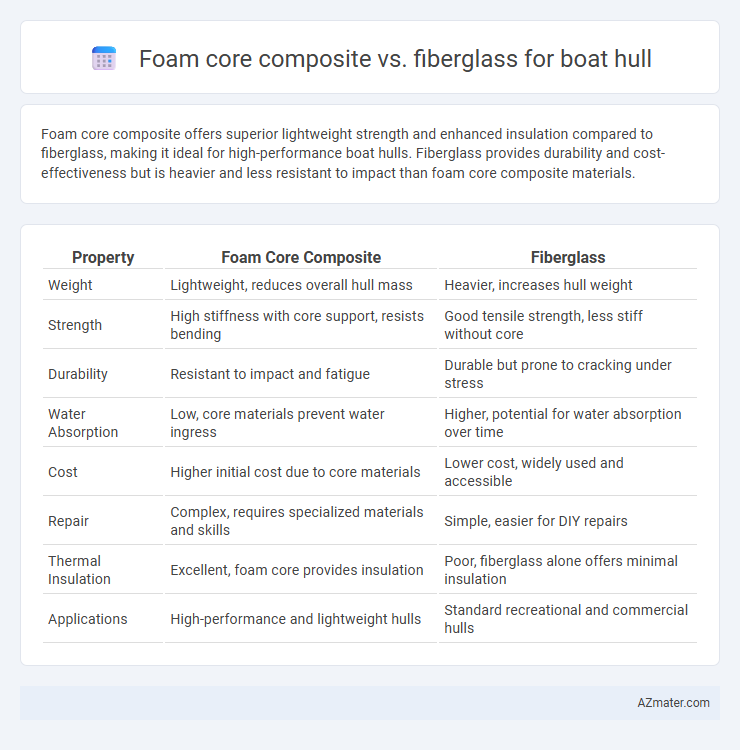Foam core composite offers superior lightweight strength and enhanced insulation compared to fiberglass, making it ideal for high-performance boat hulls. Fiberglass provides durability and cost-effectiveness but is heavier and less resistant to impact than foam core composite materials.
Table of Comparison
| Property | Foam Core Composite | Fiberglass |
|---|---|---|
| Weight | Lightweight, reduces overall hull mass | Heavier, increases hull weight |
| Strength | High stiffness with core support, resists bending | Good tensile strength, less stiff without core |
| Durability | Resistant to impact and fatigue | Durable but prone to cracking under stress |
| Water Absorption | Low, core materials prevent water ingress | Higher, potential for water absorption over time |
| Cost | Higher initial cost due to core materials | Lower cost, widely used and accessible |
| Repair | Complex, requires specialized materials and skills | Simple, easier for DIY repairs |
| Thermal Insulation | Excellent, foam core provides insulation | Poor, fiberglass alone offers minimal insulation |
| Applications | High-performance and lightweight hulls | Standard recreational and commercial hulls |
Introduction to Composite Boat Hull Materials
Foam core composite boat hulls consist of a lightweight foam core sandwiched between layers of fiberglass or carbon fiber, providing excellent strength-to-weight ratios and thermal insulation. Fiberglass hulls are constructed from woven glass fibers embedded in resin, delivering durability, impact resistance, and cost-effectiveness for various marine applications. The choice between foam core composites and traditional fiberglass depends on performance requirements, weight considerations, and budget constraints in boat building.
Overview of Foam Core Composites
Foam core composites consist of a lightweight foam core sandwiched between layers of fiberglass or carbon fiber, offering superior strength-to-weight ratio for boat hulls compared to traditional fiberglass alone. This construction enhances stiffness and impact resistance while reducing overall weight, improving fuel efficiency and performance. Foam core composites also provide better thermal insulation and resistance to water absorption, making them a durable choice in marine environments.
Key Features of Fiberglass Hull Construction
Fiberglass hull construction features high tensile strength and excellent corrosion resistance, making it ideal for durable and maintenance-friendly boat hulls. Its lightweight polyester resin matrix reinforced with glass fibers provides superior impact resistance and flexibility compared to foam core composites. Fiberglass also offers enhanced structural integrity and ease of repair, contributing to widespread use in marine vessel manufacturing.
Strength-to-Weight Comparison
Foam core composite boat hulls offer superior strength-to-weight ratios compared to traditional fiberglass, as the foam core provides enhanced stiffness and impact resistance while significantly reducing overall weight. Fiberglass hulls tend to be heavier due to solid laminate construction but remain durable, though they may lack the lightweight advantage necessary for high-performance or fuel-efficient vessels. Selecting foam core composites optimizes structural integrity without compromising agility, making them ideal for modern boat designs demanding lightweight strength.
Durability and Impact Resistance
Foam core composite boat hulls offer excellent durability by combining lightweight foam with reinforced fiberglass layers, providing superior strength-to-weight ratios and enhanced impact resistance compared to traditional fiberglass hulls. Fiberglass hulls, while robust and proven over decades, tend to be heavier and less effective at absorbing impacts, leading to potential cracks or structural damage under significant stress. Marine-grade foam cores improve energy absorption during collisions, reducing hull deformation and increasing overall lifespan in demanding marine environments.
Water Absorption and Moisture Protection
Foam core composite boat hulls exhibit significantly lower water absorption compared to fiberglass due to their closed-cell foam cores, which act as effective moisture barriers and reduce weight. Fiberglass hulls, while strong, are more prone to water penetration over time, requiring thorough sealing and maintenance to prevent core saturation and delamination. Advanced foam core composites enhance moisture protection, ensuring greater structural integrity and longevity in marine environments exposed to constant water immersion.
Thermal and Acoustic Insulation Properties
Foam core composites offer superior thermal insulation due to their closed-cell structure, reducing heat transfer and maintaining stable internal temperatures in boat hulls. Fiberglass, while durable, provides less effective thermal insulation as its porous nature allows greater heat conduction. In terms of acoustic insulation, foam core composites absorb sound waves more efficiently, minimizing vibrations and noise inside the hull, whereas fiberglass tends to transmit more noise, resulting in higher onboard sound levels.
Cost Considerations: Foam Core vs Fiberglass
Foam core composite offers a cost-efficient alternative to traditional fiberglass for boat hulls due to lower material weight, which reduces transportation and labor expenses during construction. Fiberglass, while often less expensive per square foot, may incur higher long-term maintenance costs due to its susceptibility to blistering and water absorption. Considering lifecycle costs, foam core composites provide better durability and insulation, potentially balancing initial cost differences with enhanced performance and reduced repair frequency.
Repair and Maintenance Differences
Foam core composite hulls offer easier damage detection and quicker repairs due to their lightweight and accessible core structure, reducing labor time and material costs. Fiberglass hulls, while durable, often require more extensive sanding, layering, and curing during repairs, leading to longer maintenance periods and higher material consumption. The closed-cell foam core resists water absorption, minimizing long-term maintenance compared to fiberglass, which can suffer from gelcoat cracking and osmosis if not properly maintained.
Choosing the Right Hull Material for Your Boat
Foam core composite hulls offer superior insulation and lightweight strength, making them ideal for enhanced buoyancy and fuel efficiency in boat construction. Fiberglass hulls provide exceptional durability and resistance to impact, ensuring long-lasting performance in diverse marine environments. Choosing between foam core composite and fiberglass depends on priorities such as weight savings, structural rigidity, and maintenance requirements for your specific boating needs.

Infographic: Foam core composite vs Fiberglass for Boat hull
 azmater.com
azmater.com